Key takeaways:
- Feedback plays a crucial role in enhancing campaign effectiveness by revealing blind spots and aligning messaging with audience needs.
- Types of feedback, including customer insights, internal team input, and performance data, provide a comprehensive understanding of campaign performance.
- Implementing changes based on feedback fosters audience connection and drives innovation, as seen with the introduction of interactive content and user-generated campaigns.
- Measuring the impact of adjustments is essential for understanding audience engagement and guiding future strategies through continuous improvement.
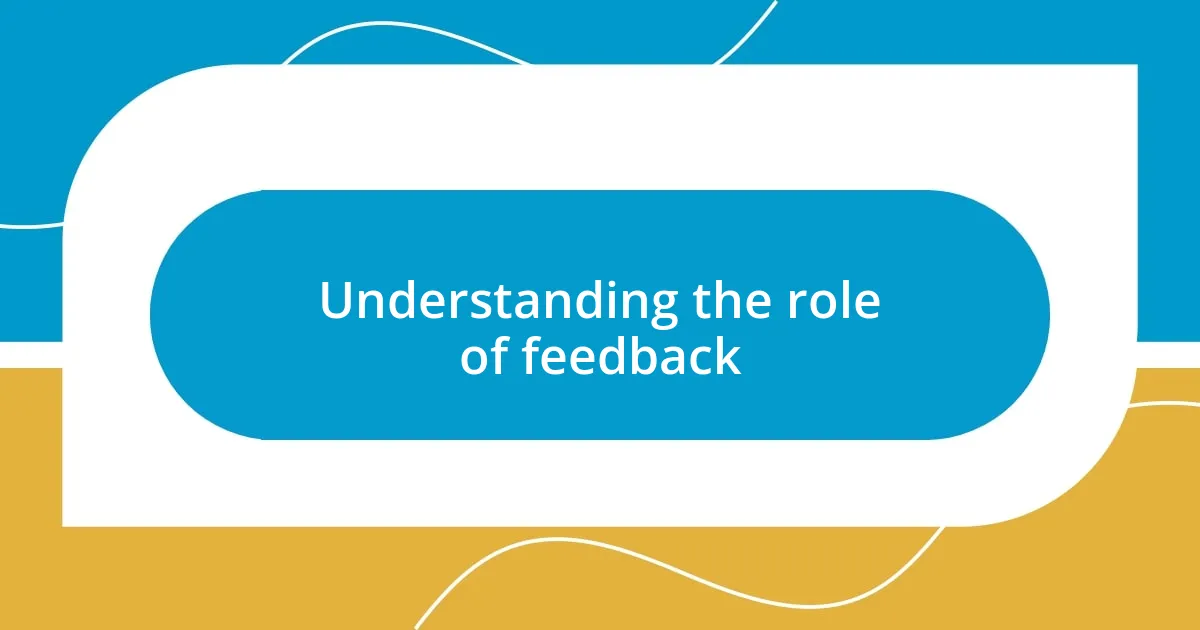
Understanding the role of feedback
Feedback is like the compass guiding us through the uncharted waters of our campaigns. I remember when I launched my first marketing initiative; I was surprised by how the feedback illuminated areas I hadn’t even considered. Have you ever noticed how a fresh perspective can highlight blind spots in our plans?
When we genuinely listen to feedback, it transforms our efforts from being one-dimensional to multifaceted. For instance, I once received conflicting opinions from my team and stakeholders about the tone of our messaging. This divergence helped me realize that effective communication hinges on alignment and understanding our audience’s needs and emotions. Isn’t it fascinating how feedback can serve as a bridge between various viewpoints, ultimately strengthening our message?
Beyond just improving our campaigns, feedback allows for growth. I’ve learned that when I welcome constructive criticism, it cultivates a culture of openness and continuous improvement. How often do we pause to reflect on the insights that come our way, and what lessons do they teach us about achieving our goals? Embracing feedback has not only refined my strategy but has also fostered deeper relationships with my team and audience.

Types of feedback to collect
I’ve discovered that there are several types of feedback I find invaluable when fine-tuning my campaigns. Customer feedback, for instance, is crucial because it offers direct insights into what resonates with the audience. I remember running a survey after a product launch that revealed unexpected preferences, which led to a significant pivot in my marketing approach.
Another type that tends to get overlooked is internal feedback from my team. This feedback often comes from those who are closer to the action and have unique perspectives. During our last campaign, I implemented regular brainstorming sessions, and the ideas that emerged reshaped our messaging and improved our campaign’s effectiveness. Who knew that listening to my team could ignite such creativity?
Lastly, performance data is a game changer. It’s like having a magnifying glass on the campaign’s success. For example, analyzing email open rates and click-through rates helped me understand what content truly engages our audience. Without this data, I wouldn’t have recognized the power of personalized subject lines, which dramatically increased our campaign’s effectiveness.
| Type of Feedback | Description |
|---|---|
| Customer Feedback | Insights from the target audience, often collected through surveys, reviews, or social media |
| Internal Feedback | Perspectives and suggestions from team members involved in the campaign |
| Performance Data | Quantitative metrics that reveal how well a campaign is performing |
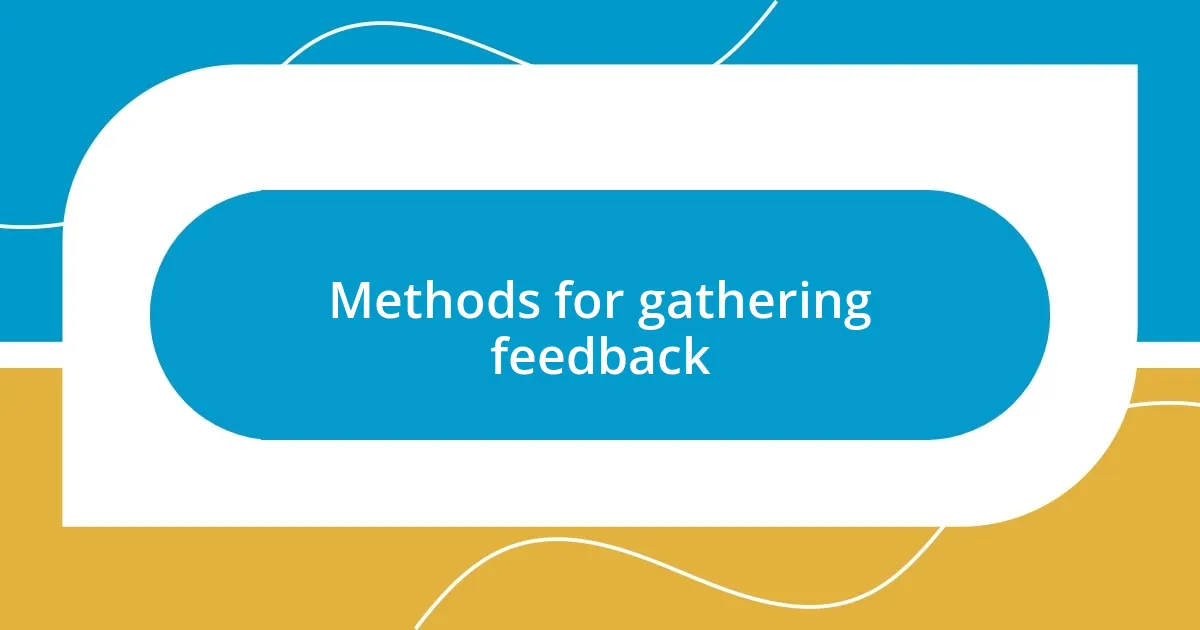
Methods for gathering feedback
When it comes to gathering feedback, I’ve found that mixing different methods provides the richest insights. For instance, I often turn to surveys for quick, structured responses. They help me gauge audience sentiment efficiently. I remember the time I launched a feedback form right after a campaign rollout, and the results shaped our next steps in unexpected ways.
Additionally, I believe in the power of face-to-face interactions. Conversations can reveal nuances that surveys might miss. Here’s a quick breakdown of methods I frequently use:
- Surveys: Quick and anonymous, allowing for direct audience insights.
- Interviews: Personal dialogue that uncovers deeper feelings and motivations.
- Focus Groups: Gathering diverse opinions, enabling rich discussions and insights.
- Social Media Listening: Monitoring comments and mentions to catch spontaneous feedback.
- Customer Reviews: Evaluating feedback on various platforms to understand overall sentiment.
Using this mix not only enriches my understanding of audience perspectives but also ensures I stay adaptable and responsive to their needs.
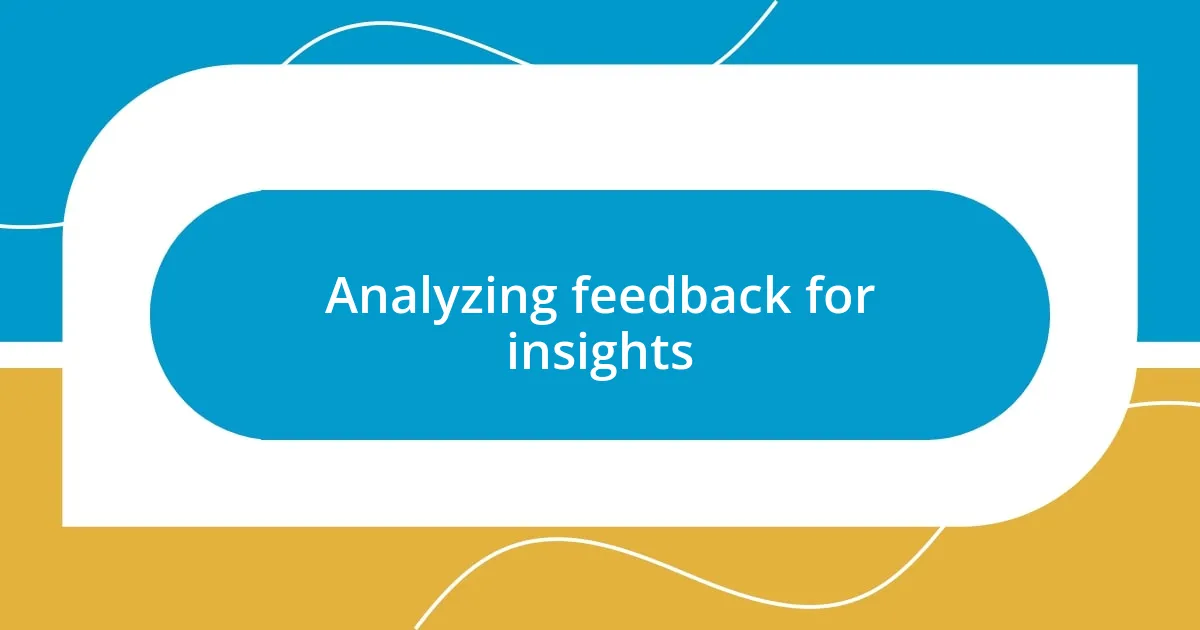
Analyzing feedback for insights
Analyzing feedback for insights has always been a transformative part of my creative process. When I sift through customer responses, I don’t just look for the obvious trends; I dive deep into the emotions behind them. For instance, after a recent campaign focused on eco-friendly products, I noticed a surge in comments that conveyed a strong sense of community connection. It sparked a realization: people weren’t just buying a product; they were embracing a lifestyle. This insight guided my next steps, allowing me to emphasize that sense of belonging in our messaging.
Taking a closer look at internal feedback from my team can be equally illuminating. One day, while reviewing our campaign’s outcomes, a teammate pointed out that we were overly focused on sales metrics and not enough on customer engagement. It struck a chord with me, reminding me that numbers alone don’t reveal the full picture. This prompted a brainstorming session where we shifted our approach to highlight the stories behind our products. The result? A campaign that felt more authentic and resonated with our audience on a personal level.
Finally, performance data isn’t just cold facts; it tells a story, and I’m fascinated by how these narratives unfold. I once noticed a dip in engagement during a particular phase of a campaign. Rather than shrug it off, I gathered the team to analyze every detail—what was different, what had changed? It turned out an A/B test we ran on visual content had not aligned with our audience’s preferences. This insight not only salvaged our ongoing campaign but also helped me understand the critical importance of testing and reacting to real-time feedback. Isn’t it fascinating how feedback can reveal underlying truths that shape our entire strategy?
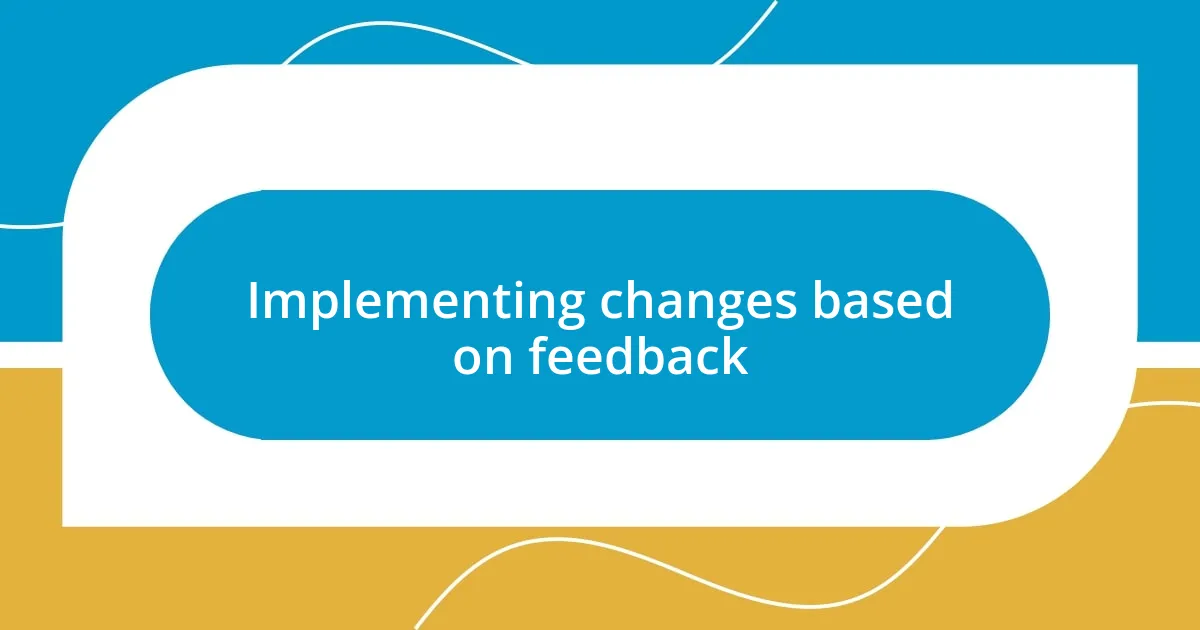
Implementing changes based on feedback
Implementing changes based on feedback can sometimes feel daunting, but I can’t stress enough how invigorating it is. For instance, during one campaign, I noticed that many respondents were calling for more interactive content. Rather than brushing it aside, I dove headfirst into creating engaging quizzes and polls. Seeing our audience react positively to these changes reminded me how vital it is to adapt and grow in response to their voices.
One memorable experience stood out when I received feedback about our website’s navigation after launching a project. A handful of users mentioned feeling lost when searching for specific information. I decided to organize a small team brainstorming session. Together, we revamped our site layout, implementing clearer categories and easier access points. The moment I saw increased user retention rates was pure joy—it reinforced how transforming feedback into actionable changes can elevate the user experience.
Ultimately, when I make adjustments based on feedback, I approach them with an open mind and heart. After all, it’s about nurturing a relationship with the audience. I once asked myself, what if we genuinely embraced their input and involved them in the creative process? So, for our next campaign, I invited a few loyal customers to co-create content with us. The result was astounding—not only did we strengthen our community ties, but the campaign felt refreshingly authentic, burst with energy, and truly represented our audience’s desires. Doesn’t that just make you want to lean into feedback even more?
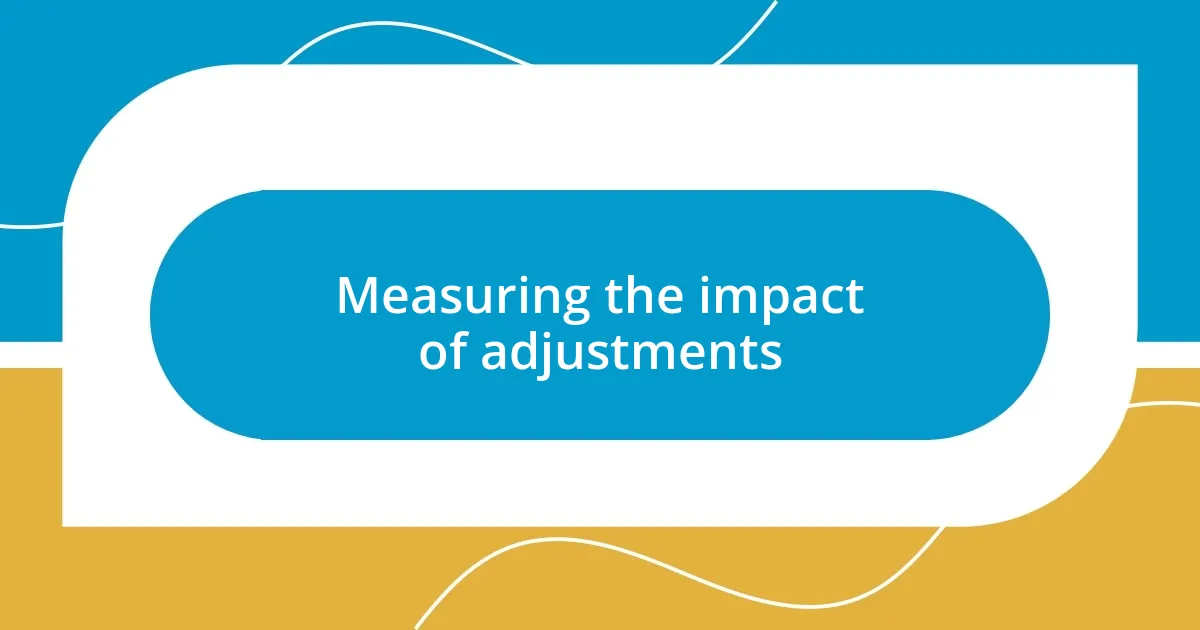
Measuring the impact of adjustments
Measuring the impact of adjustments is, in my opinion, one of the most rewarding aspects of incorporating feedback. For instance, after we revamped our email campaign based on recipient feedback, I eagerly monitored open and click rates. The spike we experienced wasn’t just numbers on a screen; it felt like a collective cheer from our audience, validating our efforts and re-energizing the team.
Looking back, I remember a project where changes were made to our social media strategy after receiving direct input from followers. We decided to feature user-generated content, and after implementing this, I tracked engagement metrics closely. Observing the significant increase in shares and comments was like finding a treasure map—each new interaction revealed deeper connections with our community. Hasn’t it often struck you how numbers can transform into stories that speak volumes about our relationship with our audience?
Through diligent analysis, I’ve learned the importance of patience when measuring change. After making adjustments, I give some breathing room before evaluating results. In one campaign, I intuitively felt that our revised approach would resonate. After a few weeks, I examined the data, and there it was: a clear upward trend. The thrill of witnessing that gradual success is a powerful reminder—sometimes, taking the time to reflect can lead to profound insights that guide your next steps. Don’t you find it fascinating how every adjustment can open the door to new understanding?
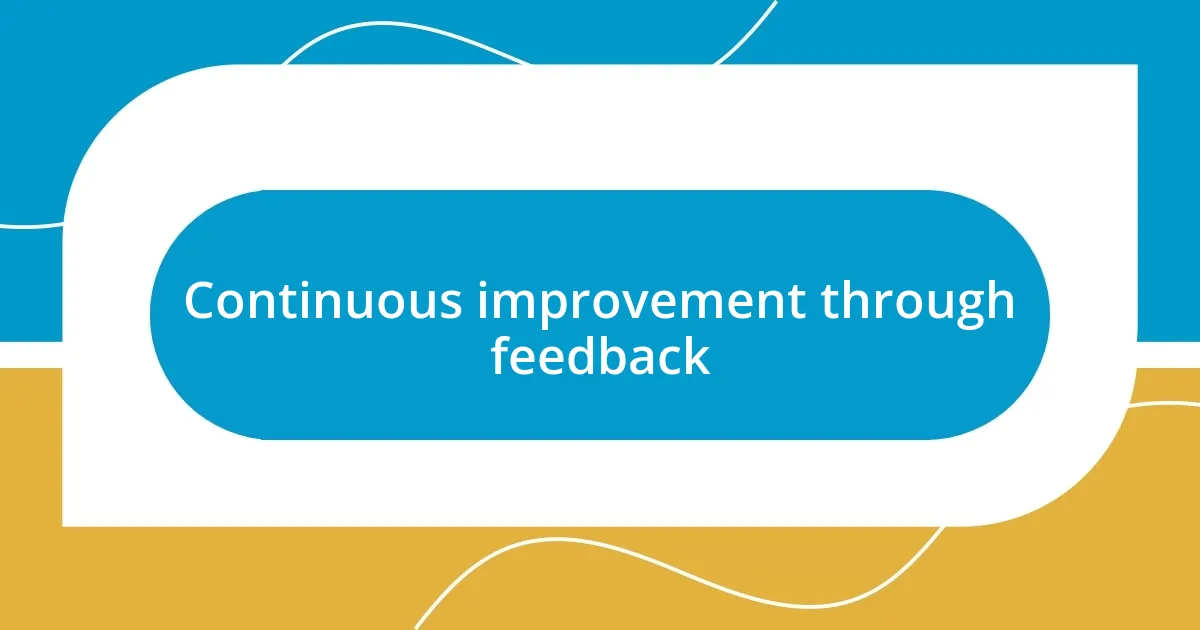
Continuous improvement through feedback














